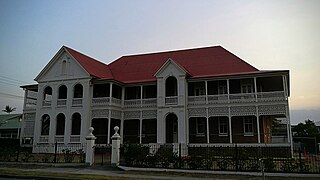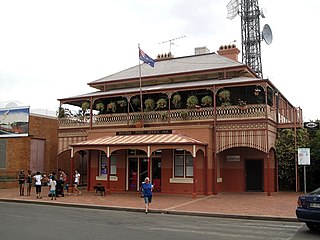
Rooty Hill is a suburb of Sydney, in the state of New South Wales, Australia. Rooty Hill is located 42 kilometres west of the Sydney central business district, in the local government area of the City of Blacktown and is part of the Greater Western Sydney region.

The Norman Lindsay Gallery and Museum is the former residence and farmlet of Australian artist Norman Lindsay. Now an art gallery, tourist attraction and museum located at 14-20 Norman Lindsay Crescent in the Blue Mountains town of Faulconbridge in the City of Blue Mountains local government area of New South Wales, Australia, it was built from 1898 to 1913 by Francis Foy, Patrick Ryan, Lindsay, and the artist's wife, Rose Soady. The property, owned by the National Trust of Australia (NSW), is also known as Maryville and Springwood.

Riverstone railway station is a heritage-listed railway station serving the Sydney suburb of Riverstone in New South Wales, Australia. It was designed by the NSW Government Railways and William Weaver and built from 1883 to 1939. The station is located on the Richmond line, and is served by Sydney Trains T1 Western and T5 Cumberland line services. The property was added to the New South Wales State Heritage Register on 2 April 1999.

Mount Druitt is a suburb of Sydney, in the state of New South Wales, Australia. It is located 43 kilometres (27 mi) west of the Sydney central business district, in the local government area of the City of Blacktown, and is part of the Greater Western Sydney region.

Blacktown City Council is a local government area in Western Sydney, situated on the Cumberland Plain, approximately 35 kilometres (22 mi) west of the Sydney central business district, in the state of New South Wales, Australia. Established in 1906 as the Blacktown Shire and becoming the Municipality of Blacktown in 1961 before gaining city status in 1979, the City occupies an area of 246.9 square kilometres (95.3 sq mi) and has a population of 410,419, making it the most populous local government area in Sydney.

Berry Museum is a heritage-listed former council chambers and bank building and now museum at 135 Queen Street, Berry, City of Shoalhaven, New South Wales, Australia. It was designed by William Wilkinson Wardell and built from 1884 to 1885 by W. Stoddart. It is also known as the E.S.&A. Bank or the ANZ Bank. The property is owned by Shoalhaven City Council. It was added to the New South Wales State Heritage Register on 1 September 2006.

The Mount Druitt Town Rangers, or Mt Druitt Rangers, are a soccer club from Mount Druitt in Western Sydney, Australia. The club was incorporated in 1970. The team currently plays in the New South Wales National Premier Leagues 1, the highest league in the state and second highest in the country after the A-League. Winning promoted having won the Club Championship in 2018 season from NSW NPL2.

Mount Carmel Convent is a heritage-listed Roman Catholic former convent at 199 Bay Terrace, Wynnum, City of Brisbane, Queensland, Australia. It was designed by Hall & Dods and built in 1915 by William Richard Juster. It was added to the Queensland Heritage Register on 27 August 1999.

Imperial Hotel is a heritage-listed Australian pub at 1 Rooty Hill Road North, Rooty Hill, City of Blacktown, Sydney, New South Wales, Australia. The property is owned by Dyemist Pty Ltd. It was added to the New South Wales State Heritage Register on 2 April 1999.

The Manse is a heritage-listed former residence and now community museum at 23 The Avenue, Mount Druitt, City of Blacktown, Sydney, New South Wales, Australia. It was probably built by local notable, John Harris. It is also known as Methodist Manse. The property is owned by Blacktown City Council. It was added to the New South Wales State Heritage Register on 2 April 1999.

Prospect Post Office is a heritage-listed former post office and shop at 23 Tarlington Place, Prospect, City of Blacktown, New South Wales, Australia. It was designed by James Watts and built by Watts from 1880 to 1890. The property is owned by the City of Blacktown. It was added to the New South Wales State Heritage Register on 2 April 1999.

Dayton House is a heritage-listed farm house at 37-39 Roger Place, Seven Hills, City of Blacktown, New South Wales, Australia. It was built in 1834. It is also known as Bates Farm. It was added to the New South Wales State Heritage Register on 2 April 1999.

Bourke Post Office is a heritage-listed post office at 47 Oxley Street, Bourke, Bourke Shire, New South Wales, Australia. It was designed by the Colonial Architect's Office under James Barnet and built in 1880 by E. Heseler. It is also known as Bourke Post and Telegraph Office. The property is owned by the Keane Family Trust. It was added to the New South Wales State Heritage Register on 23 June 2000.

Homewood is a heritage-listed house and farm at 1279 Nulla Nulla Creek Road, Bellbrook, Kempsey Shire, New South Wales, Australia. It was the childhood home of country music singer Slim Dusty. It was designed by his father, David Kirkpatrick, and built from 1915 to 1916 by Kirkpatrick and Thomas Ryan. It is also known as Melody Farm. The property is now owned by Slim Dusty's widow, Joy McKean Kirkpatrick. It was added to the New South Wales State Heritage Register on 27 January 2012.

Corunna Road Sewer Vent and Cottage is a heritage-listed sewer vent and residence at 125 Corunna Road, Stanmore, Inner West Council, Sydney, New South Wales, Australia. It was designed by the NSW Public Works Department and built by the department in 1900. It was added to the New South Wales State Heritage Register on 15 November 2002.

Hampton Villa is a heritage-listed residence at 12b Grafton Street, Balmain, Inner West Council, New South Wales, Australia. It was built c. 1847-1849 by Edward Hunt; the design is uncertain, but has been attributed to John Verge. Among its notable residents was Henry Parkes, tenant from 1888 to 1892. The villa replaced an earlier building known as Hampton Cottage. It was added to the New South Wales State Heritage Register on 27 May 2005.

Fernhill is a heritage-listed former house and former inn located beside the Great Western Highway in Bowenfels, City of Lithgow, New South Wales, Australia. It was built from 1856 to 1859 by John Blackman. It is also known as Australia Arms Inn. The property is owned by National Trust of Australia (NSW). It was added to the New South Wales State Heritage Register on 2 April 1999. On 18 July 2019 it was sold as a residential property.
Rose Cottage and Early Slab Hut is a heritage-listed former residence and farm house and now vacant building, at the corner of Water Street and Tennant Road, in the western Sydney suburb of Werrington in the City of Penrith local government area of New South Wales, Australia. It was designed in a vernacular style and built from 1810 to 1870, possibly by the Andrews family. The property is owned by Department of Planning and Infrastructure, a department of the Government of New South Wales. It was added to the New South Wales State Heritage Register on 2 April 1999.

182 Cumberland Street, The Rocks is a heritage-listed retail building and residence located at 182 Cumberland Street, in the inner city Sydney suburb of The Rocks in the City of Sydney local government area of New South Wales, Australia. It was designed by Walter Liberty Vernon with the assistance of E. L. Drew and built from 1911 to 1912. The property is owned by Property NSW, an agency of the Government of New South Wales. It was added to the New South Wales State Heritage Register on 10 May 2002.

Undercliffe Terrace is a heritage-listed row of terrace houses located at 52–60 Argyle Place, in the inner city Sydney suburb of Millers Point in the City of Sydney local government area of New South Wales, Australia. The property is also known as Grimes' Buildings. was added to the New South Wales State Heritage Register on 2 April 1999.




















